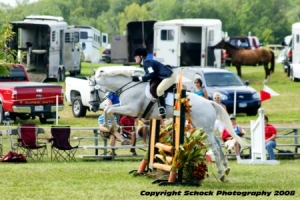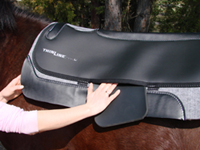Saddle Fitting the Thoroughbred Horse
The Thoroughbred horse, especially the off the track race horse, can be one of the more daunting breeds to saddle correctly. Most people take one look at their sharp, high wither, the shoulders, and the rest of the back will take a real beating. Here in MN and WI, I have not fitted a Thoroughbred in anything other than a medium wide or wide tree for years.
The reason for this is the breeders who have done such a wonderful job improving this breed, with broad chests and well sprung ribs. Those that race do come off the track with their share of issues, but they can be dealt with relatively inexpensively and it does not take a great deal of time.

When I first met Navarre, an off the track TB, he was in a gorgeous saddle sadly two tree sizes too small. He had a huge swooping wither and severe muscle wastage under the too narrow saddle points. When I reached inside the channel of the saddle, the stirrup bars were like vises against the long muscles of his back. Palpation had to be very gentle as he came close to dropping to his knees under any pressure. I showed his rider how to do the essential belly lift, drawing a thumb along the center line of his bell and told her every change she got, to raise his back. The 30 cm saddle was replaced with a 34 cm wide saddle tree and a ThinLine sheepskin saddle pad.
If you are not familiar with ThinLine, this product is my saddle fitting dream-come-true saddle pad. I have tested tons of different pads and until I put ThinLine to a two week test, never found anything that did what I was looking for. ThinLine asked me to try their pads for two weeks. I rode my two correctly saddled stallions one day with the ThinLine, the next without. At the end of that time, I called Elaine Lockhead, owner of ThinLine and said, sign me up!
With the ThinLine my horses’ gaits were larger and had more swing. My aids were more like thoughts than actions. And most important of all was the feeling like two hands reaching up into the saddle, pressing my seat bones upward as my guys lifted their backs when the ThinLine was part of the saddling equation.
Why ThinLine works is its unique construction — open — cell foam which moves shock, weight, and heat laterally. Beginning as a liquid, microscopic cells are poured into a mold, then polarized so each cell lies end to end creating a tunnel. Another layer is poured on top and polarized in a new direction. In each ThinLine pad, this process is repeated hundreds of times, creating a honey comb matrix which is breathable as well. ThinLine products also carry tensile strength so that pressure is evenly distributed: filling in hollow points while relieving pressure points AT THE SAME TIME!

What I have found with the TB’s I’ve worked with is that they all seem to have read Mary Wanless’ book, ‘For the Goo of the Horse.” In this book, Mary reports about a study done in England where they tested just how much a horse’s back would grow, given the chance. In the study, some of the horses increased their back width seven time! this same study discovered what happens when a saddle that is too small is not changed — just like Navarre, the muscling hits the tree, then backs off. If this goes on too long, the backing off becomes muscle wastage and then the next thing you know, soundness issues start popping up. Little wonder – you’d be unsound too if someone made you gallop and jump in shoes two or three sizes too small.
With Navarre, we had a more than happy ending. Two days after we changed his saddling and added the ThinLine Correction Sheepskin saddle pad, he was at Trott Brook, our largest Event in MN. He placed fifth in a large field with Sieren Peterson on board. But even more gratifying, when I recheck his saddle month later, his back was not only healed, but turning into a gorgeous field of new muscle.
If you have a Thoroughbred in your life, don’t let their withers lead you into doing the wrong thing. When evaluating a saddle, do so without any pads or a girth. Check the channel. All ThinLine pads except the basics have a spine free channel and pockets for adding ThinLine saddle fit shims. And lastly, reach under the stirrup bars. This is an area that doesn’t get checked frequently enough.
There are many very reasonably priced saddles that work well with the TB back, but I would only use a wool flocked saddle with them as the structure of this breed is close to the skin and thus easily soared by incorrect fit. When not able to turn to a more expensive custom saddle, my favorite combination always includes a wider rather than narrower tree and a ThinLine pad which can be shimmed to allow the muscle that will appear with this combination.
If saddling your TB with a Western saddle, I highly recommend that you avail yourself the Steel “Fit to Be Seen” system. This series of fiberglass forms, made up in the shape of the most popular bars, is the only good way to really see the impact of a Western saddle on the back and wither. While doing this, it is very important to make sure the horse’s back is raised. If the horse is in pain and the back is dropped, you could end up saddling the problem rather than the solution. With all my new Western Dressage and Western Reining Riders I recommend the Western Dressage liner or the Felt pads. Again all take shims allowing for saddle adjustment while the horses develop better back muscles.
If I can be any help answering your questions, you can contact me through my website, www.saddlefitter.com, or call at 651-462-5654. Ride happy!
Cordia Pearson, SMS
Saddle Fitting the Thoroughbred Horse





